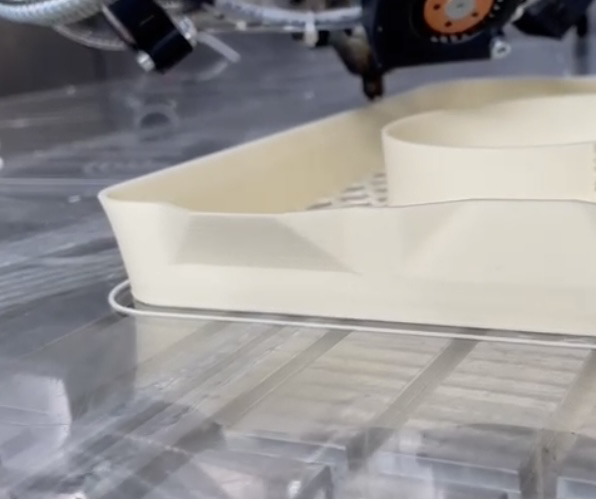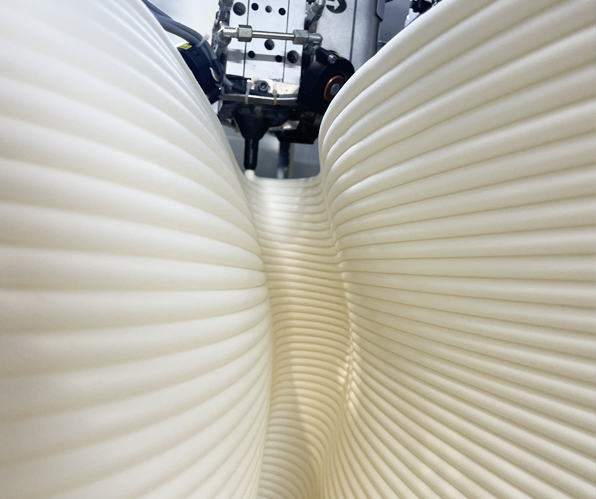The large-scale 3D printing space is heating up in both polymers and concrete. Medium-format systems are also finding more applications. In uses such as formwork, molds, large-scale tooling and even end-use parts, we’re seeing more and more applications for large 3D printed items. Companies such as Thermwood, Cincinnati, Juggerbot, CEAD and more are jumping into the space. Large parts also use up an awful lot of feedstock, so its no surprise that the materials companies are diving into the segment, as well. Early interest from Mitsubishi, DSM (now Covestro), and SABIC has helped to mature the market.
A perhaps surprising entrant in this space is ColorFabb. The Dutch firm is a leader in desktop 3D printing filament and now hopes to extend its reach into larger industrial parts. It’s doing this by launching its foaming materials for the fused granulate fabrication (FGF) market—so, not filament but granulate based material extrusion. And it’s doing so with large-format 3D printer manufacturer, Colossus Printers.
FGF should be much cheaper than filament per kilo and that really has a lot of impact when it comes to large parts. Furthermore ColorFabb’s foaming materials, such as lightweight PLA (LW-PLA), mean that you can print lighter components or print much faster than with non-foaming materials. The companies suggest that combining the materials of ColorFabb with the machines of Colossus, they’re able to double printing speed and can make one-cm layers with 8mm nozzles.
We interviewed Philippe-Daniel Merillet the founder of Collusus and ColorFabb’s CEO Ruud Rouleaux to find out more about the partnership. We spoke Ralph van den Borst, two years ago when he joined colorFabb. What has changed over the years?
“We have seen LW-PLA become one of our bestselling materials. It was quickly adopted by the Remote-Controlled Airplane community we have started to offer this in 6 different colors as well. It is also being used in cosplay and fir other light weight items. Parts are feather light, yet retain good strength and are easy to cut, trim and sand. If part weight matters to you, then this is your filament of choice,” Ruud Rouleaux said. “We also further specialized our competences to make custom made materials for our customers upon their requests. One of our latest materials we have released is PLA Semi Matte Black. A less brittle and stunning PLA filament. Only for those who are looking to make their prints look super cool. The non-gloss semi-matte black filament is all style and no compromise.”
Meanwhile, Colossus is attempting to tackle the large-format space with more add-on features. Philippe-Daniel Merillet explained:
“We focus our energy on bringing full circle solutions with the best quality integrations and add ons. This means best extrusion technology, optimized print system integrations, continuously upgrading our software, and bringing more and specialized materials to the FGF market as this provides additional opportunities. We aim to push the boundaries and bring new and innovative advantages to the technology to extend the market adaptation. Doing this with some of the best partners in the business allows us to accelerate the impact, for our clients and the entire industry.”

Colossus chose to focus only on FGF machines with the goal of transforming waste plastic into new objects quickly and in a cost-effective manner. Colossus systems, therefore, are designed to be an industrial and transportable method for doing so.
“While filament printing has its set benefits and market segment and will always have its place in the market, I believe industrial applications will move towards pellet printing. For large-scale printing granulates is the only real financially viable consumable, as it is widely known that pellets are cheaper feedstock. Besides this its easier to recycle and easier to handle for volume printing. Our integrated dryers contain up to 60 Liter of a material with an extended capacity with automatic refilling if needed, this means industrial processes and speeds and/or capacity is never a limitation,” Merillet said.
Merillet further suggested that FGF systems are more complicated with more process parameters to adapt for a given material. This includes multiple heating zones, pressure, and melt pump settings. However, Colossus attempts to address these concerns by providing material profiles.
“We believe in providing printers as a solution for users’ applications rather than selling a machine. It should be our experience that helps the client print with ease and obtain results faster,” Merillet said. “Rather than searching through pages of technical data sheets to identify the right temperatures for six heating zones and identify the correct pressure settings for each material, we supply pre-installed material profiles for all requested material types. We strive to make our systems as close to filament as possible so that anyone with 100 hours experience on a desktop printer can use the system with a day or two of training.”
Lightweight materials, such as foams, could have tremendous advantages, according to the partners. These include increased print speed and reduced weight. The use of these materials in pellet printing means bringing these benefits to already fast, large printers.
“When I first saw LW PLA as a filament print, i knew this material would be revolutionary for the FGF market. The principle is almost designed for FGF technology,” Merillet explained. “Printing twice as fast, twice as light, both are factors that scales with print volume exponentially. The larger you print, the larger the impact. Applying the principle to large-scale print systems only using pellets means you can easily alternate very low and very high layer heights on nozzles ranging from 1mm to 8mm, reaching a wide variety of results on a single machine. Additionally, making FGF 3D printing both environmentally but also financially sustainable is what drives me. By using the foaming technique correctly and having this material stable for large-scale extrusion, parts can be produced rapidly, creating a financial advantage towards industrial adaptation.”

When asked about the future of 3D printing, Ruud concluded:
“3D Printing enables creative minds to develop truly innovative product / material combinations. In many business segments we’re witnessing continuous disruptive breakthroughs. In the next years we’ll see the rise large scale 3D printing that will enable more new sustainable business practices based on 3D printing and natural materials.”
Subscribe to Our Email Newsletter
Stay up-to-date on all the latest news from the 3D printing industry and receive information and offers from third party vendors.
You May Also Like
Further Understanding of 3D Printing Design at ADDITIV Design World
ADDITIV is back once again! This time, the virtual platform for additive manufacturing will be holding the first-ever edition of ADDITIV Design World on May 23rd from 9:00 AM –...
3D Printer Maker EVO-tech Reborn as NEVO3D — Once More With Feeling
EVO-tech was a 3D printing service and original equipment manufacturer established in 2013 and based in Schörfling am Attersee, Austria. The company produced high-quality material extrusion systems featuring linear bearings,...
3D Systems Brings 3D Printed PEEK Cranial Implant to the U.S. with FDA Clearance
For more than 10 years, 3D Systems (NYSE:DDD) has worked hand-in-hand with surgeons to plan over 150,000 patient-specific cases, and develop more than two million instruments and implants from its...
CDFAM Returns to Berlin for Second Annual Symposium
The second CDFAM Computational Design Symposium is scheduled for May 7-8, 2024, in Berlin, and will convene leading experts in computational design across all scales. Building upon the first event...































